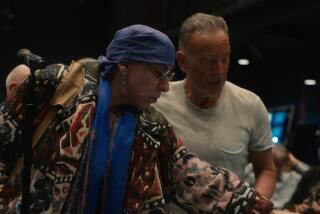Putting a ‘Shine’ on Rolling Stones
- Share via
Who would have thought that the Rolling Stones would turn into the house band for the plutocracy, singing at a benefit for the Clinton Foundation with a cluster of hedge-fund hotties front and center? Who would have thought that Mick Jagger would be performing a sizzling duet of “Live With Me” with a singer (Christina Aguilera) who wasn’t even born until 11 years after he wrote the song? Who would have thought the Stones would be performing at all when the cumulative ages of the members reached 255 years?
Mick Jagger would have, that’s who.
When asked by Dick Cavett in 1972 whether “you can picture yourself at age 60 doing what you do now,” Jagger grinned and responded, “Easily, yeah.” Period, close quote, end of story.
What “Shine a Light,” Martin Scorsese’s concert documentary, does beautifully is illuminate the way things are now with the self-described world’s greatest rock ‘n’ roll band. We see that benefit show and a Clinton birthday concert, filmed over two nights in 2006 at New York’s Beacon Theatre, and by the time it’s all over, we are thoroughly entertained. But getting to that point turns out to have been a tougher slog than might be expected.
What makes it tough, frankly, is all those accumulated years. It’s not that the group has any difficulty performing up to its standards, it’s that youth and anarchy (not always Bill Clinton’s areas) are part of rock’s DNA, and seeing the Stones as up close and personal as a concert film demands, presents us with the unnerving spectacle of their battle-hardened, not to say sepulchral, faces.
This is especially the case with Jagger. Yes he can still run and jump with the best of them, but on camera, that movement plays like a practiced performance untouched by genuine emotion. Rather than feeling the music, we are wondering who does his hair and what kind of an exercise and stretching routine he maintains.
On the other hand, though, “Sympathy for the Devil” makes us wonder if Jagger really is Mr. Scratch. This is especially true after the band’s rendition of “As Tears Go By,” originally recorded by Marianne Faithfull, reminds us of how differently age has treated these former lovers.
Paradoxically, age is hardly a problem at all with Keith Richards. With his exceptional ability to lose himself in the music -- “I don’t think on stage, I feel,” he says at one point -- the guitarist looks like a wraith from another dimension, a being beyond both space and time.
If the overall age of the group is a problem, “Shine a Light” has the resources to combat and overcome it, key among them being the amount of filmmaking craft and skill director Scorsese and his team bring to the proceedings.
A meticulous planner and music aficionado who worked on “Woodstock” and whose credits include “The Last Waltz” and two excellent PBS music documentary series, Scorsese is also a film preservationist who seems to relish the task of conserving the almost retro nature of these concerts, shooting not in 3-D in massive soccer stadiums the way U2 did, but in 35 millimeter in a relatively intimate Broadway theater.
And though “Shine a Light” is largely a concert documentary, Scorsese has shrewdly included a smattering of other material, including the Dick Cavett chat.
There’s some behind-the-scenes footage emphasizing the comic opera aspects of preparation -- “We cannot burn Mick Jagger,” the director says sternly when a lighting issue makes immolation a possibility -- as well as a selection of mostly inane interviews the group has endured over the years.
The heart of “Shine a Light,” though, is the marvelous performance footage the 18 cameramen, led by director of photography Robert Richardson and including such major talents as Robert Elswit, John Toll, Albert Maysles, Stuart Dryburgh, Andrew Lesnie, Emmanuel Lubezki, Declan Quinn and Ellen Kuras, have managed to capture.
As put together in a frankly heroic nine-month job of editing by David Tedeschi, this remarkable footage casually captures wonderful moments of musicianship and style, from Buddy Guy’s intense guitar work on “Champagne and Reefer” to Ronnie Wood’s hypnotic pedal steel solo on “Far Away Eyes” as well as Mr. Richards coolly spitting a cigarette out of his mouth just because he wants to.
Finally, it is the scorching intensity of the blues- and R&B-inflected; songs the Stones play, not any on-stage antics, that keeps the group involved in performing and the audience keyed into the film. With expert backup singers and veteran musicians such as Bobby Keys on tenor sax and Darryl Jones on bass providing a solid grounding, the music’s insistent richness builds and builds, its sound becoming so deep and persuasive that qualms about age fade and the rhythms carry us away.
The Stones have been in any number of memorable films, including 1970’s “Gimme Shelter” and Robert Frank’s documentary with the unprintable name, but this outing is special, both because of where it arrives and the obstacles it faced along the way. “Shine a Light” may not be the last Rolling Stones movie, but it’s likely to be the last one with a touch of the poet about it.
--
--
“Shine a Light.” MPAA rating: PG-13 for brief strong language, drug references and smoking. Running time: 2 hours, 2 minutes. In limited release.
More to Read
The biggest entertainment stories
Get our big stories about Hollywood, film, television, music, arts, culture and more right in your inbox as soon as they publish.
You may occasionally receive promotional content from the Los Angeles Times.











